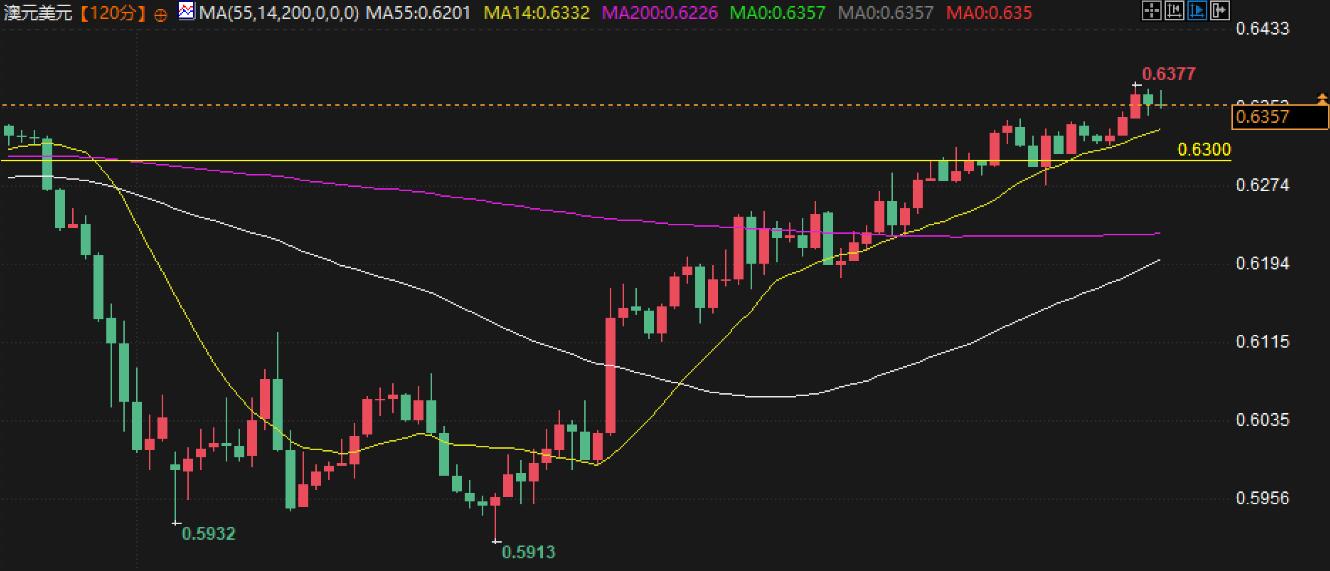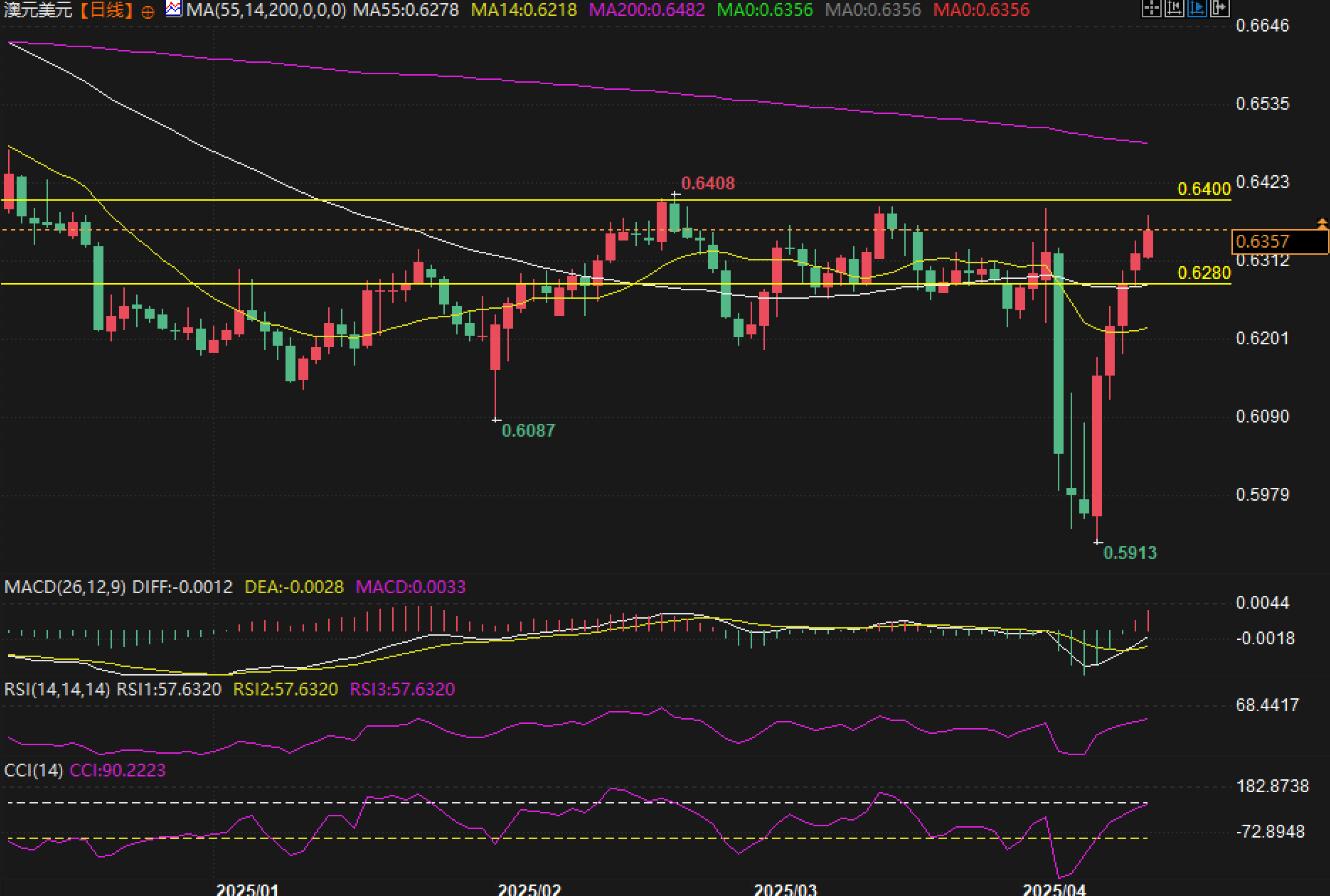Forex trading analysis: AUD/USD five consecutive gains under tariff storm
On Tuesday (April 15th), the AUD/USD exchange rate strengthened for the fifth consecutive trading day. After US President Trump announced a "amnesty" for key technology products, global risk sentiment was boosted, benefiting the Australian dollar.
Fundamental analysis
The minutes of the Reserve Bank of Australia (RBA) meeting from March 31 to April 1 indicate that the timing of the next interest rate adjustment is still uncertain. Although the committee pointed out that the May meeting would be an appropriate time to reassess policies, it emphasized that no decisions have been predetermined yet. The committee acknowledges that global uncertainty, particularly regarding US tariffs, may significantly impact future prospects. The Federal Reserve also emphasized the upward and downward risks facing the Australian economy and inflation.
The yield on Australian 10-year government bonds has fallen to approximately 4.33%. Although the Reserve Bank of Australia has kept interest rates unchanged this month, it has taken a more moderate stance on future rate cuts and pointed out that core inflation is slowing down. The market currently expects a 25 basis point interest rate cut in May, and expects a total interest rate cut of about 120 basis points for the whole year.
At the same time, the US Dollar Index (DXY) has rebounded slightly after hitting its lowest point since 2022 and is currently trading around 99.70 as the market responds to signs of growing stagflation risk in the United States. The University of Michigan sentiment index fell to 50.8 in April, while one-year inflation expectations climbed to 6.7%. The Producer Price Index (PPI) rose 2.7% year-on-year in March, lower than the 3.2% in February, and the core rate slowed down to 3.3%. The number of unemployment benefit applicants has increased to 223000, but the number of renewals has decreased to 1.85 million, indicating a mixed situation in the labor market.
Last Sunday, Minneapolis Fed President Kashkari stated that the economic impact caused by trade frictions will largely depend on how quickly trade uncertainty is resolved. He commented, "In the past 10 years, except for March 2020, this was the biggest blow to confidence during my tenure at the Federal Reserve
Technical analyst interpretation:
From the 120 minute chart, the AUD/USD exchange rate shows a clear upward trend. The exchange rate has continued to rebound since the low point of 0.5913 and has now broken through multiple moving average resistance lines. The MACD indicator shows that DIFF: 0.0037 and DEA: 0.0038 are about to form a golden cross, while the RSI indicator remains stable at the level of 64.2592, in a strong but not yet oversold state. The current price has formed an upward trend, with a key support level around 0.6300. In the short term, as long as the exchange rate can hold the support of 0.6300, the upward movement is expected to continue, and the next resistance level is looking towards the psychological level of 0.6400.

From the daily cycle observation, the Australian dollar/US dollar is currently in the follow-up stage of a V-shaped reversal after experiencing a severe pullback in early April. The exchange rate has recently rebounded strongly from the low point of 0.5913, filling most of the gap. The key resistance level is at 0.6408, which is the high point area in the early stage. Although the daily MACD indicator is still in the negative zone, the gap between DIFF and DEA is narrowing, indicating that medium-term momentum is improving. The current value of RSI indicator is 57.6320, which is in a neutral to strong state. It is worth noting that the 200 day moving average (MA200) is at 0.6482, which constitutes a significant resistance in the medium to long term. From the perspective of volatility, after experiencing significant fluctuations, the exchange rate is currently seeking direction within the range of 0.6280-0.6400, which will be the focus of attention in the future.

Market sentiment observation
The current market sentiment is undergoing a transition from extreme panic to cautious optimism. The Trump administration's decision to grant amnesty to technology products has eased market concerns about global supply chain disruptions. This measure is seen as a signal of policy flexibility and also eased market concerns about the overall deterioration of trade relations.
Judging from the performance of the Australian dollar, the market's preference for risky assets is recovering. Analysis of fund flow shows that some traders are reallocating emerging market and commodity currency assets, with the Australian dollar being one of the preferred high-risk currencies with high liquidity.
However, caution still exists. The warnings from multiple Federal Reserve officials regarding the persistence of inflation and the fact that the US dollar index has fallen below the 100 point mark indicate that the market has not completely shaken off concerns about an economic slowdown. The RSI indicator is in a neutral strong zone rather than an overbought zone, which also reflects that the market mentality is still relatively cautious and there are no signs of excessive optimism.
Future prospects
Short term outlook: In the next week, the Australian dollar/US dollar is expected to maintain a strong trend, but the upward trend may face an important resistance band in the 0.6400-0.6450 range. Pay attention to RBA officials' speeches this week and US retail sales data, which may become triggering factors for short-term exchange rate fluctuations. If it can effectively break through 0.6400, it may open up a new round of upward momentum; On the contrary, if it falls below 0.6280, it may retest the key support of 0.6200.
Mid term outlook: From a fundamental perspective, the Australian dollar faces two opposing forces: on the one hand, the easing of global trade relations will benefit commodity currencies; On the other hand, the expected narrowing of the interest rate differential between Australia and the United States has suppressed the Australian dollar. In the next 1-2 months, the key technical point is 0.6500, and a breakthrough at this high point will determine whether the medium-term trend can continue.
Long term outlook: In the long run, the trend of AUD/USD will depend more on the global economic growth prospects and the degree of policy differentiation among central banks of various countries. If the market's expectation of a global economic soft landing strengthens, the Australian dollar is expected to break through 0.6600 or even challenge the level of 0.6800; On the contrary, if trade frictions reignite or global growth slows significantly, the 0.5900-0.6000 region will become an important defense line. From a long-term technical perspective, we are currently in the final stage of a correction in the medium to long term upward trend. If we can successfully stabilize above 0.6400, we are expected to start a new round of upward cycle.
Note: The fundamental content of this article is based on reports from Refinitiv.
Tips:This page came from Internet, which is not standing for FXCUE opinions of this website.
Statement:Contact us if the content violates the law or your rights
